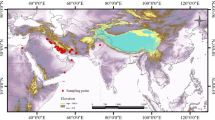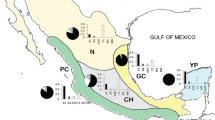Abstract
Determining the relationships between environmental variables and genetic diversity is critical to understand the processes that drive evolution in species-contact areas. We employed a combination of modeling approaches and multivariate statistical analyses to analyze mtDNA diversity in a hybrid zone between two evolutionary lineages of honeybees in order to interpret the microevolutionary processes that led to the observed spatial pattern of diversity. The model located the west European honeybee lineage mainly across temperate areas characterized by mild winters and high water availability throughout the year, whereas the African lineage was mainly associated with warmer and drier areas. Selection could be playing an important role in shaping the life history evolution, particularly affecting the mitochondria, and also resulting in hitchhiking effects on particular regions of the mitochondrial genome.





Similar content being viewed by others
References
Angers B, Magnan P, Plantes M, Bernatchez L (1999) Canonical correspondence analysis for estimating spatial and environmental effects on microsatellite gene diversity in brook charr (Salvelinus fontinalis). Mol Ecol 8:1053–1403
Arias M, Rinderer T, Sheppard W (2006) Further characterization of honey bees from the Iberian Peninsula by allozyme, morphometric and mtDNA haplotype analyses. J Apic Res 45(4):188–196
Ballard W, Kreitman M (1995) Is mitochondrial DNA a strictly neutral marker? Trends Ecol Evol 10:485–488
Barrett R, Schluter D (2007) Adaptation from standing genetic variation. Trends Ecol Evol 23:38–44
Boyce M, Vernier P, Nielsen S, Schmiegelow F (2002) Evaluating resource selection functions. Ecol Model 157:281–300
Cánovas F, De la Rúa P, Serrano J, Galián J (2002) Variabilidad del ADN mitocondrial en poblaciones de Apis mellifera iberica de Galicia (NW España). Arch Zootec 51:441–448
Cánovas F, De la Rúa P, Galián J, Serrano J (2008) Geographical patterns of mitochondrial DNA variation in Apis mellifera iberiensis (Hymenoptera: Apidae). J Zool Syst Evol Res 46:24–30
Cánovas F, De la Rúa P, Serrano J, Galián J (2011) Microsatellite variability reveals beekeeping influences on Iberian honeybee populations. Apidologie 42:235–251
Chávez-Galarza J, Henriques D, Johnston JS, Azevedo JC, Patton JC, Muñoz I, De la Rúa P, Pinto MA (2013) Signatures of selection in the Iberian honey bee (Apis mellifera iberiensis) revealed by a genome scan analysis of single nucleotide polymorphisms. Mol Ecol 22(23):5890–5907
Cheesel D (1992) The ade4 package-I: one-table methods. R News 4:5–10
Collins WD, Bitz CM, Blackmon ML, Bonan GB, Bretherton CS, Carton JA, Chang P, Doney SC, Hack JJ, Henderson TB, Kiehl JT, Large WG, McKenna DS, Santer BD, Smith RD (2006) The community climate system model version 3 (CCSM3). J Clim 19:2122–2143
Danforth B (2007) Bees. Curr Biol 17:156–161
De la Rúa P, Galián J, Serrano J (1999) Variabilidad del ADN mitocondrial en poblaciones de abejas de la miel (Apis mellifera L.) de la Región de Murcia. Invest Agric Prod San Anim 14:41–49
De la Rúa P, Galián J, Serrano J, Moritz RFA (2001) Molecular characterization and population structure of the honeybees from the Balearic Islands (Spain). Apidologie 32:417–427
De la Rúa P, Jiménez Y, Galián J, Serrano J (2004) Evaluation of the biodiversity of honey bee (Apis mellifera) populations from eastern Spain. J Apic Res 43:162–166
De la Rúa P, Hernández-García R, Jiménez Y, Galián J, Serrano J (2005a) Biodiversity of Apis mellifera iberica (Hymenoptera: Apidae) from northeastern Spain assessed by mitochondrial analysis. Insect Syst Evol 36:21–28
De la Rúa P, Fuchs S, Serrano J (2005b) Biogeography of European honey bees. In: Lodesani M, Costa C (eds) Beekeeping and conserving biodiversity of honeybees. Sustainable bee breeding, theoretical and practical guide. Northern Bee Books, Hebden Bridge, pp 15–52
Dowling D, Friberg U, Lindell J (2008) Evolutionary implications of non-neutral mitochondrial genetic variation. Trends Ecol Evol 23:546–554
Elekonich M, Roberts S (2005) Honey bees as a model for understanding mechanisms of life history transitions. Comp Biochem Physiol A 141:362–371
Elith J, Phillips S, Hastie T, Dudík M, Chee Y, Yates CJ (2011) A statistical explanation of MaxEnt for ecologists. Divers Distrib 17(1):43–57
El-Niweiri M, Moritz R (2011) Mating in the rain? Climatic variance for polyandry in the honeybee (Apis mellifera jemenitica). Pop Ecol 53(3):421–427
Engel MS (1999) The taxonomy of recent and fossil honey bees (Hymenoptera: Apidae; Apis). J Hymenopt Res 8(2):165–196
Fielding A, Bell J (1997) A review of methods for the assessment of prediction errors in conservation presence/absence models. Environ Conserv 24:38–49
Franck P, Garnery L, Solignac M, Cornuet J (1998) The origin of West European subspecies of honeybees (Apis mellifera): new insights from microsatellite mitochondrial data. Evolution 52(4):1119–1134
Franck P, Garnery L, Loiseau A, Hepburn HR, Solignac M, Cornuet JM (2001) Genetic diversity of the honeybee in Africa: microsatellite mitochondrial data. Heredity 86:420–430
Garnery L, Solignac M, Celebrano G, Cornuet JM (1993) A simple test using restricted PCR-amplified mitochondrial DNA to study the genetic structures of Apis mellifera L. Experientia 49:1016–1021
Garnery L, Frank P, Baudry E, Vautrin D, Cornuet J, Solignac M (1998a) Genetic diversity of the west European honeybee (Apis mellifera mellifera and A. m. iberica). I. Mitochondrial DNA. Genet Sel Evol 30(1):31–47
Garnery L, Frank P, Baudry E, Vautrin D, Cornuet J, Solignac M (1998b) Genetic diversity of the west European honeybee (Apis mellifera mellifera A. m. iberica). II. Microsatellite loci. Genet Sel Evol 30(1):49–74
González-Trueba J, Martín-Moreno R, de Pisón EM, Serrano E (2008) ‘Little Ice Age’ glaciation and current glaciers in the Iberian Peninsula. Holocene 18:551–568
Gordo O, Sanz J (2005) Phenology and climate change: a long- term study in a Mediterranean locality. Oecologia 146:484–495
Gordo O, Sanz J (2006) Temporal trends in phenology of the honey bee Apis mellifera (L.) and the small white Pieris rapae (L.) in the Iberian Peninsula (1952–2004). Ecol Entomol 31:261–268
GRASS Development Team (2008) Geographic resources analysis support system (GRASS GIS) software. Open source geospatial foundation. http://grass.osgeo.org
Hanotte O, Bradley D, Ochieng J, Verjee Y, Hill E, Rege EO (2002) African pastoralism: genetic imprints of origins and migrations. Science 296:336–339
Hastie T, Tibshirani R (1990) Generalized additive models. Chapman and Hall, London
Hasumi H, Emori S (2004) K-1 coupled GCM (MIROC) description. Center for Climate System Research, University of Tokyo, Tokyo p 34
Hickling R, Roy D, Hill J, Fox R, Thomas C (2006) The distributions of a wide range of taxonomic groups are expanding polewards. Glob Chang Biol 12:450–455
Hijmans R, Cameron S, Parra L, Jones P, Jarvis A (2005) Very high resolution interpolated climate surfaces for global land areas. Int J Climatol 25:1965–1978
Hirzel A, Le Lay G, Helfer V, Randin C, Guisan A (2006) Evaluating the ability of habitat suitability. Ecol Model 199:142–152
Jombart T, Pontier D, Dufour A (2009) Genetic markers in the playground of multivariate analysis. Heredity 102(4):330–341
Kindt R, Coe R (2005) Tree diversity analysis: a manual and software for common statistical methods for ecological and biodiversity studies. World Agroforestry Centre, Nairobi
Kovac H, Stabentheiner A, Schmaranzer S (2010) Thermoregulation of water foraging honeybees-balancing of endothermic activity with radiative heat gain and functional requirements. J Insect Physiol 56(12):1834–1845
Le Conte Y, Navajas M (2008) Climate change: impact on honey bee populations and diseases economically valuable species. Rev Sci Technol 27(2):499–510
Lehmann A, Overton JM, Leathwik JR (2002) GRASP: generalized regression analysis and spatial predictions. Ecol Model 157:187–205
Lodesani M, Costa C (2005) Beekeeping and conserving biodiversity of honeybees. Sustainable bee breeding, theoretical and practical guide. Northern Bee Books, Hebden Bridge
Markham C (1970) Seasonality of precipitation in the United States. Ann Assoc Amer Geograph 60:593–597
Miguel I, Iriondo M, Garnery L, Sheppard WS, Estonba A (2007) Gene flow within the M evolutionary lineage of Apis mellifera: role of the Pyrenees, isolation by distance and post-glacial recolonization routes in the Western Europe. Apidologie 38:141–155
Miguel I, Baylac M, Iriondo M, Manzano C, Garnery L, Estonba A (2011) Both geometric morphometric and microsatellite data consistently support the differentiation of the Apis mellifera M evolutionary branch. Apidologie 42(2):150–161
Pinto MA, Henriques D, Neto M, Guedes H, Muñoz I, Azevedo J, de la Rúa P (2013) Maternal diversity patterns of Ibero-Atlantic populations reveal further complexity of Iberian honeybees. Apidologie 44:430–439
R Development Core Team (2009) R: a language and environment for statistical computing. R Foundation for Statistical Computing, Vienna, Austria. http://www.R-project.org/. ISBN 3-900051-07-0
Ruttner F (1988) Biogeography and taxonomy of honeybees. Springer, Berlin
Ruttner F, Tassencourt L, Louveaux J (1978) Biometrical-statistical analysis of the geographic variability of Apis mellifera L. Apidologie 9(4):363–381
Schütt B (2005) Late quaternary environmental change on the Iberian Peninsula. Erde 136:3–14
Segurado P, Araujo MB (2004) An evaluation of methods for modelling species distributions. J Biogeogr 31:1555–1568
Smith D, Glenn T (1995) Allozyme polymorphisms in Spanish honeybees (Apis mellifera iberica). J Hered 86:12–16
Smith D, Palopoli M, Taylor B, Garnery L, Cornuet J, Solignac M, Brown WM (1991) Geographical overlap of two mitochondrial genomes in Spanish honeybees (Apis mellifera iberica). J Hered 82:96–100
Thomas C, Bodsworth E, Wilson R, Simmons A, Davies Z, Conradt L (2001) Ecological and evolutionary processes at expanding range margins. Nature 411:577–581
Venables W, Ripley B (2004) Modern applied statistics with S. Springer, New York
Whitfield C, Behura S, Berlocher S, Clark A (2006) Thrice out of Africa : ancient and recent expansions of the honey bee, Apis mellifera. Science 314:642–645
Wood S (2006) Generalized additive models: an introduction with R. Chapman and Hall, London
Wood S, Augustin N (2002) GAMs with integrated model selection using penalized regression splines and applications to environmental modelling. Ecol Model 157:157–177
Zayed A, Whitfield C (2008) A genome-wide signature of positive selection in ancient and recent invasive expansions of the honey bee Apis mellifera. Proc Natl Acad Sci USA 105:3421–3426
Acknowledgments
We thank all the bee-keepers and associations (particularly Coordinadora de Organizaciones de Agricultores y Ganaderos, COAG) that generously contributed samples and their time. We thank O. Rodríguez, J. Ornia, E. Muñiz and U. Mediel. Thanks to R. Angus, who helped us improve the manuscript with their comments and suggestions during the revision process. This work was supported by projects RZ00-013 (Spanish National Institute of Agricultural Investigation, INIA) and EVK2 2000-00628 (BABE, V European Union Framework). F. Cánovas is supported by a post-doctoral fellowship from the FCT (Fundacão para Ciência e Tecnologia, Portugal). This study was conducted entirely using open source software.
Author information
Authors and Affiliations
Corresponding author
Electronic supplementary material
Below is the link to the electronic supplementary material.
Rights and permissions
About this article
Cite this article
Cánovas, F., De la Rúa, P., Serrano, J. et al. Analysis of a contact area between two distinct evolutionary honeybee units: an ecological perspective. J Insect Conserv 18, 927–937 (2014). https://doi.org/10.1007/s10841-014-9701-1
Received:
Accepted:
Published:
Issue Date:
DOI: https://doi.org/10.1007/s10841-014-9701-1




